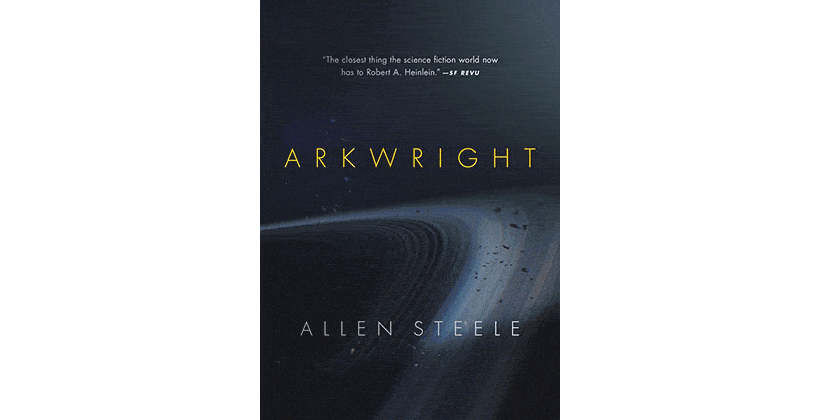Category: Fiction
Reviewed by: Peter Spasov
Title: Arkwright
Author: Alan Steele
NSS Amazon link for this book
Format: Hardcover/Paperback/Kindle
Pages: 336
Publisher: Tom Doherty Associates
Date: March 2016
Retail Price: $15.65/$8.79/$10.14
ISBN: 978-0765382153
This is a hard science story that spans five generations of the Arkwright family Their long-range goal is to colonize a distant planet twenty two light years from Earth within a period of a hundred years. Allen Steele, a two-time Hugo Award-winning author, has organized this book into sections separated by brief interludes. The title both hints and misdirects. Ark comes to mind for an interstellar ship, but Arkwright is the family name of the primary character that started this venture.
The prologue opens with a choice: Nathan Arkwright chooses how he will die. Then it teases the reader about who this famous author is. Book One generally covers Nathan’s association with early science fiction history including several real-life writers and others. He achieves financial success and forms a lasting friendship with a core group. Later they form the Arkwright foundation to begin the enterprise of interstellar colonization. They consider alternative starship ideas such as very long-term life support and hibernation challenges while discussing actual investigative projects done to date. There is a mystery concerning Nathan and his daughter which the author only answers several chapters later. His granddaughter joins the foundation to continue on to the next section of the book.
An interlude fast forwards a generation later to when actual starship construction occurs. The financing comes from investing in start-ups who develop technology relevant to the program. In Book Two another generation is at work to launch the starship. Despite a fanatical group’s attempt to halt the mission, the foundation completes the assembly of the ship in Earth orbit and launches it to the target star. This section also includes a diagram labelling the main components of the vessel.
The next interlude has a recording where Nathan Arkwright addresses those who will carry out the work he has begun. Book Three covers the many years when the ship is underway. It is the story of the next generation as they maintain communications, which is progressively challenging because of lengthy time delays. It is during this time when a major crisis occurs and is overcome, rescuing both the mission and society on Earth.
The next interlude covers the ship’s arrival at the star system from a machine’s point of view. In Book Four the reader experiences a completely different world, perhaps reminiscent of an old Bradbury type story. There are strange people with features adapted for life on a recently terraformed planet with one and half times Earth gravity. They use language different but derived from ours and have their own origin mythology. Eventually a second ship arrives with fully-mature humans and things change for the original settler society. The recent arrivals have used advanced hibernation technology.
Throughout the book Steele shows us how the foundation proceeds with colonization in an entertaining way including suspense, character details and conflict. The plan is thus: Put a powerful solar powersat in a Langrage orbit. It will beam microwaves to a ship with a very large sail to accelerate it to half light speed in about a year. The ship will coast until it approaches the Gliese 667 triple-star system. A combination of magsail and gravity assist operations slow down the ship. The ship carries frozen sperm and eggs from human donors plus other material to terraform the target planet with an ecosystem. Onboard artificial intelligence and robotics will ensure this all happens. Steele bases his plan on current research and proposals such as 100 Year Starship Symposium mentioned in the acknowledgements. Probably the biggest challenge is using robot nannies to birth and raise humans in a very foreign world. He also includes moral dilemmas such as whether to change an alien ecology should one be encountered. The novel also mentions the possibility of alien life using different molecular chirality.
There are some inconsistencies with the plot in my opinion. The ship is equipped with advanced artificial intelligence capable of operating the ship and artificial wombs plus raising humans to adulthood over a span of a hundred plus years. Yet the tracking station has aging computers with maintenance issues. Another concerns communications time delays. Possibly I misunderstood, but I believe the author erred by not accounting for ship travel while a message from Earth is beamed to it. However these issues did not detract from a book I enjoyed for both its story elements and speculative solution to colonizing a star system. The latter is well-reasoned and easily understandable. I also find it interesting when a work of fiction includes a bibliography.
© 2017 Peter Spasov
Please use the NSS Amazon Link for all your book and other purchases. It helps NSS and does not cost you a cent! Bookmark this link for ALL your Amazon shopping!



















